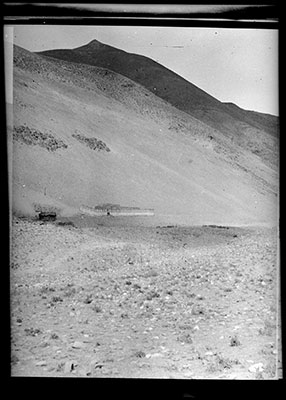
2001.59.5.74.1 (Film negative)


2001.59.5.74.1 (Film negative)

Hugh E. Richardson
Hugh Richardson
1950?
Khangmar Region > Iwang
2001.59.5.74.1
54 X 43 mm
Negative film nitrate
Donated August 2001
The executors of the estate of Hugh E. Richardson
Hugh E. Richardson
Manual Catalogues - Notes on negative album - '5' 'Yaso. Serpang. Byamspa gdan dren. Taarpa gling Oracle, lhosar [?] ceremonies. Jo mo lhari, Phari' is written on the negative album in white in Richardson's hand. [KC 31/7/2006]
Manual Catalogues - Notes on negative index - Folio 74. 'IWANG' [KC 31/7/2006]
Manual Catalogues - Richardson's Handlist - 'Vol. 5' . no .74. 'The temple of I-wang. Very early, described by Tucci in Indo-Tibetic IV. Yar 'bros -mtsho and Gnod-sbyin gang bzang (or Nor-‘dzin gangs-bzang).' [KC 7/9/2006]
Other Information - Richardson mentions the monastery of I-wang in High Peaks, Pure Earth , London: Serindia Publications, 1998, p. 328. "There are many interesting monaasteries between Gyantse and Gro-mo (or Yatung, Sna-gdong). [In the same vicinity as Samada, some sixty miles south of Gyantse] there are other small eleventh century temples: Rkyang-phu , Rgya-gnas and I-wang (or G.ye-mar ). All have fine, well-decorated clay images, those at I-wang being especially noteworthy; some are actually described by inscriptions as being in the Indian style, others in the style of Li (Khotan). ... Both at I-wang and Rkyang-phu are stucco figures on the walls depicting the temptation of the Buddha by Mara." [KC 7/9/2006]
Other Information - The monastery of I-wang is also known as Yemar (g.ye dmar|) and situation in Khangmar (khang dmar) district. The monastery is said to have been founded in the 11th century by Lharje Chojang (lha rje chos byang). A detailed description of the monastery can be found in Giuseppee Tucci, Indo-Tibetica 1V.1 Gyantse and Its Monasteries, Aditya Prakashan, New Delhi, 1989. pp: 134-141. (TS)
For Citation use:
The Tibet Album.
"Iwang monastery in the Khangmar region"
05 Dec. 2006. The Pitt Rivers Museum.
<http://tibet.prm.ox.ac.uk/photo_2001.59.5.74.1.html>.
For more information about photographic usage or to order prints, please visit the The Pitt Rivers Museum.
© The Pitt Rivers Museum